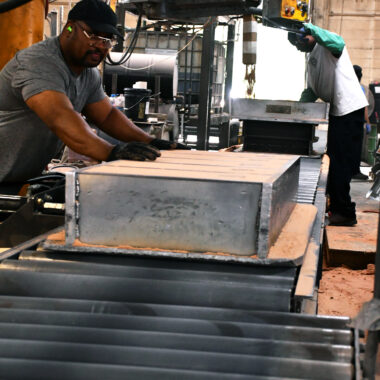Transform Your Production with Aluminum Casting Innovations
Transform Your Production with Aluminum Casting Innovations
Blog Article
Study the Globe of Aluminum Casting: Recognizing the Various Techniques
Light weight aluminum casting is a basic process in the production sector, with different approaches used to create complex and precise components. From the typical sand casting technique to the innovative die casting process, each technique supplies distinct advantages depending on the needs of the project.
Sand Casting Technique
Sand casting, a widely-used technique in aluminum casting processes, involves developing mold and mildews made of compressed sand for putting liquified steel. When the mold is prepared, it is securely positioned in a flask and molten light weight aluminum is poured right into the dental caries.
After the steel has cooled and solidified, the sand mold and mildew is escaped to expose the aluminum casting. Sand spreading enables for the production of complex forms and huge parts that may be costly or challenging to produce making use of various other methods. It is also a lasting method as the sand can be recycled and made use of several times, decreasing waste in the spreading procedure.
Permanent Mold And Mildew Method

One considerable advantage of the Permanent Mold And Mildew Method is the boosted dimensional precision it supplies. The steel mold enables for tighter tolerances and better details in the last light weight aluminum spreadings contrasted to sand spreading methods. This precision makes it a preferred selection for applications where limited dimensional control is vital, such as in the automotive and aerospace sectors.

Die Casting Refine

Investment Casting Approach
Making use of an accuracy casting approach, Investment Casting Strategy entails developing complex light weight aluminum parts by pouring liquified metal into a ceramic mold. This process, additionally known as lost-wax spreading, starts with the development of a wax pattern of the wanted component. This wax pattern is then covered with a ceramic material to develop a covering. When the ceramic covering is set, it is heated to remove the wax, leaving a hollow ceramic mold and mildew.
The next step involves putting the molten light weight aluminum into the ceramic mold. The aluminum fills up the tooth cavity left by the wax pattern, taking its form exactly. This approach is favored for its ability to generate intricate shapes with high accuracy and a smooth surface coating. Financial investment spreading is frequently made use Recommended Reading of for manufacturing elements in industries where limited tolerances and detailed designs are required, such as aerospace, vehicle, and medical tools. The convenience and accuracy of the Financial investment Casting Method make it a beneficial technique in the globe of aluminum casting.
Lost Foam Spreading Method
Having checked out the complex accuracy of Financial investment Casting Strategy, the emphasis currently changes to the cutting-edge method of Lost Foam Casting in light weight aluminum element production. Lost Foam Casting, also referred to as evaporative pattern casting, is a contemporary strategy where a foam pattern of the wanted component is developed and after that covered with useful content a refractory product. The layered foam pattern is after that hidden in sand, and molten light weight aluminum is put right into the mold and mildew. As the steel loads the mold and mildew, the foam vaporizes due to the warm, leaving a tidy tooth cavity in the shape of the desired part.
Furthermore, Lost Foam Casting is a cost-efficient process as it lowers the requirement for cores and permits for the production of light-weight components. In spite of its advantages, Lost Foam Casting calls for careful control of the spreading procedure to avoid issues and guarantee high quality parts.
Conclusion
To conclude, light weight aluminum casting uses a selection of methods such as sand spreading, irreversible mold method, pass away spreading, financial investment casting, and lost foam spreading. Each approach has its own advantages and applications, making aluminum casting a functional and extensively used process in different markets. Recognizing the differences between these techniques is vital Get More Info in picking the most suitable casting method for certain manufacturing needs.
Sand spreading, a widely-used approach in light weight aluminum casting processes, involves creating molds made of compacted sand for pouring molten metal. aluminum casting.The Permanent Mold Technique, like sand casting, is one more common technique utilized in aluminum casting processes, offering distinct advantages in terms of mold and mildew reusability and dimensional precision. The steel mold and mildew permits for tighter resistances and finer information in the final light weight aluminum spreadings contrasted to sand spreading techniques. The 2 primary types of die casting are chilly chamber die casting and warm chamber pass away spreading, each appropriate for different types of aluminum alloys.In verdict, light weight aluminum spreading uses a range of methods such as sand casting, permanent mold and mildew strategy, pass away casting, investment spreading, and shed foam casting
Report this page